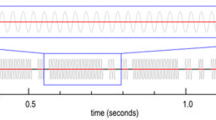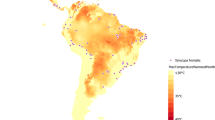Abstract
The aim of this paper is to provide the first complete description of ventilating activity undertaken by the Oriental hornet. At the portal of each nest of the Oriental hornet (Vespa orientalis, Hymenoptera, Vespinae) there are worker hornets that beat their wings in synchrony with one another, during summer months and at the onset of daylight. These ventilating hornets stand at regular intervals around the nest entrance, not touching, and with their heads facing largely outwards. Although the ventilating hornets stand apart from one another, their wings beat at a uniform pace and there is no connection whatsoever between these hornets and the sentinel worker hornet (or hornets) that inspect those entering the nest. The ventilatory wing beating lasts 3.4 min on average, and upon completion, the ventilating worker either emerges to forage in the field or more often retreats back into the nest. Young queens have seldom been seen ventilating and males have never been seen engaged in such activity. Ordinarily, no ventilatory activity takes place upon the brood combs inside, such as is observed in artificial breeding boxes with a transparent wall, but on rare occasions ventilation may also occur on the inner side of the portal. In cases where there is more than one portal to the nest, the ventilatory activity will occur at each of these sites. Apparently every hornet worker engages in such ventilation at one time or another and their number at any one time is temperature-dependent, that is, the higher the ambient temperature the greater the number the hornets participating in ventilation. Indeed the correlation between the temperature and the ventilatory activity is positive and highly significant.











Similar content being viewed by others
References
Gaul AT (1952) Additions to vespine biology IX. Temperature regulation in the colony. Bull Brookline Entomol Soc 47:79–82
Heinrich B (1981) Insect thermoregulation. Wiley, New York
Himmer A (1932) Die Temperaturverhältnisse bei den socialen Hymenopteren. Biol Rev 7:224–253
Ishay J (1964) Observations sur la biologie de la Guêpe orientale Vespa orientalis en Israël. Insectes Soc [XI] 3:193–206
Ishay J (1967) Observations on the behavior of the different members of a colony of the Oriental hornet Vespa orientalis. PhD thesis, The Hebrew University, Jerusalem
Ishay JS, Kirshboim S (2000) Ultraviolet B light stimulates hornet activities—a review. Semicond Sci Technol Inst Phys 15:704–723
Ishay J, Ruttner F (1971) Die thermoregulation im Hornisennest. Z Vergl Physiol 72:423–434
Ishay J, Sadeh D (1975) Direction finding of hornets under gravitational and centrifugal forces. Science 190(4216):802–804
Ishay J, Bytinski-Saltz H, Shulov A (1967) Contributions to the bionomics of the Oriental hornet Vespa orientalis. Isr J Entomol II:45–106
Sadeh D, Ishay J, Yotam R (1977) Hornet ventilation noise: rhythm and energy content. Experientia 33:335–337
Author information
Authors and Affiliations
Corresponding author
About this article
Cite this article
Riabinin, K., Kozhevnikov, M. & Ishay, J.S. Ventilating activity at the hornet nest entrance. J Ethol 22, 49–53 (2004). https://doi.org/10.1007/s10164-003-0098-7
Received:
Accepted:
Published:
Issue Date:
DOI: https://doi.org/10.1007/s10164-003-0098-7




